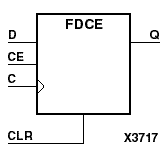| XC3000 | XC4000E | XC4000X | XC5200 | XC9000 | Spartan | SpartanXL | Virtex |
|---|---|---|---|---|---|---|---|
| Primitive | Primitive | Primitive | Primitive | Primitive | Primitive | Primitive | Primitive |

FDCE is a single D-type flip-flop with clock enable and asynchronous clear. When clock enable (CE) is High and asynchronous clear (CLR) is Low, the data on the data input (D) of FDCE is transferred to the corresponding data output (Q) during the Low-to-High clock (C) transition. When CLR is High, it overrides all other inputs and resets the data output (Q) Low. When CE is Low, clock transitions are ignored.
The flip-flop is asynchronously cleared, output Low, when power is applied. For CPLDs, the power-on condition can be simulated by applying a High-level pulse on the PRLD global net. FPGAs simulate power-on when global reset (GR) or global set/reset (GSR) is active. GR for XC3000 is active-Low. GR for XC5200 and GSR (XC4000, Spartans, Virtex) default to active-High but can be inverted by adding an inverter in front of the GR/GSR input of the STARTUP or STARTUP_VIRTEX symbol.
For XC9500XL devices, logic connected to the clock enable (CE) input is unconditionally implemented using the clock enable product-term of the XC9500XL macrocell. Only FDCE and FDPE flip-flops use the XC9500XL clock enable product-term.
| Inputs | Outputs | |||
|---|---|---|---|---|
| CLR | CE | D | C | Q |
| 1 | X | X | X | 0 |
| 0 | 0 | X | X | No Chg |
| 0 | 1 | 1 | 1 | |
| 0 | 1 | 0 | 0 | |